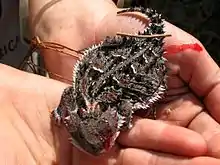| Mexican Plateau horned lizard | |
|---|---|
 | |
| P. orbiculare in Veracruz, Mexico, showing blood squirted from eye as defensive behavior. | |
| Scientific classification | |
| Domain: | Eukaryota |
| Kingdom: | Animalia |
| Phylum: | Chordata |
| Class: | Reptilia |
| Order: | Squamata |
| Suborder: | Iguania |
| Family: | Phrynosomatidae |
| Genus: | Phrynosoma |
| Species: | P. orbiculare |
| Binomial name | |
| Phrynosoma orbiculare | |
| Synonyms[2] | |
| |
The Mexican Plateau horned lizard[4] (Phrynosoma orbiculare) is a species of horned lizard in the family Phrynosomatidae.[2] The species, also known commonly as the Chihuahua Desert horned lizard,[5] is endemic to Mexico. There are five recognized subspecies. The specific epithet, orbiculare, comes from the Latin adjective orbis, meaning "circular".[4]
Description
%252C_Municipality_of_Miquihuana%252C_Tamaulipas%252C_Mexico_(24_September_2009).jpg.webp)
P. orbiculare has a characteristic single row of lateral abdominal fringe scales. This "horned toad" also has two short occipital horns.[5]
Geographic range
P. orbiculare is found only in the high plateau country of central Mexico. Specifically, it is found in the Mexican states of Chihuahua, Durango, Morelos, Nuevo León, Puebla, and Veracruz.[5]
Habitat
P. orbiculare occurs in a wide range of primary habitats (dry scrubland, pine-oak forest, oak forest, juniper forest) and secondary habitats (agricultural land, and agave and Opuntia fields).[1]
Subspecies
Five subspecies of P. orbiculare are recognized as being valid, including the nominotypical subspecies.[2]
- Phrynosoma orbiculare bradti Horowitz, 1955
- Phrynosoma orbiculare cortezii (A.H.A. Duméril & Bocourt, 1870)
- Phrynosoma orbiculare dugesii (A.H.A. Duméril & Bocourt, 1870)
- Phrynosoma orbiculare orbiculare (Linnaeus, 1758)
- Phrynosoma orbiculare orientale Horowitz, 1955
Nota bene: A trinomial authority in parentheses indicates that the subspecies was originally described in a genus other than Phrynosoma.
Reproduction
P. orbicularis is viviparous.[2]
Etymology
The subspecific name, cortezii, is in honor of Spanish conquistador Hernán Cortés.[6]
The subspecific name, dugesii, is in honor of French-born Mexican naturalist Alfredo Dugès, who is considered the "father" of Mexican herpetology.[6]
References
- 1 2 Mendoza-Quijano, F.; Vázquez Díaz, J.; Quintero Díaz, G.E. (2007). "Phrynosoma orbiculare". IUCN Red List of Threatened Species. 2007: e.T64079A12734405. doi:10.2305/IUCN.UK.2007.RLTS.T64079A12734405.en. Retrieved 20 November 2021.
- 1 2 3 4 5 Phrynosoma orbiculare at the Reptarium.cz Reptile Database. Accessed 30 October 2015.
- ↑ "Phrynosoma orbiculare (Linnaeus, 1758)". Integrated Taxonomic Information System. Retrieved 30 October 2015.
- 1 2 Sherbrooke, Wade C. (2003). Introduction to Horned Lizards of North America. University of California Press. p. 61. ISBN 9780520926752.
- 1 2 3 Hodges, Wendy (2003). "Phrynosoma orbiculare, Chihuahua Desert Horned Lizard". Digimorph.org. Retrieved 30 October 2015.
- 1 2 Beolens, Bo; Watkins, Michael; Grayson, Michael (2011). The Eponym Dictionary of Reptiles. Baltimore: Johns Hopkins University Press. xiii + 296 pp. ISBN 978-1-4214-0135-5. (Phrynosoma orbiculare cortezii, p. 60; P. o. dugesii, p. 76).
Further reading
- Boulenger GA (1885). Catalogue of the Lizards in the British Museum (Natural History). Second Edition. Volume II. Iguanidæ ... London: Trustees of the British Museum (Natural History). (Taylor and Francis, printers). xiii + 497 pp. + Plates I-XXIV. (Phrynosoma orbiculare, pp. 241–243).
- Horowitz SB (1955). "An arrangement of the subspecies of the horned toad, Phrynosoma orbiculare (Iguanidae)". American Midland Naturalist 54 (1): 204–218. (Phrynosoma orbiculare bradti, new subspecies; P. orbiculare orientale, new subspecies).
- Linnaeus C (1758). Systema naturæ per regna tria naturæ, secundum classes, ordines, genera, species, cum characteribus, differentiis, synonymis, locis. Tomus I. Editio Decima, Reformata. Stockholm: L. Salvius. 824 pp. (Lacerta orbicularis, new species, p. 206). (in Latin).
